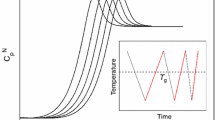Summary
Starting from both the three-dimensional diagram of viscoelastic properties in the reciprocal temperature — log frequency — space and the time-temperature interrelation via apparent activation energy of flow, the possibility of theoretical interpretation of the isochronal behaviour is demonstrated, in analogy to the isothermal one. The determinative apparent activation energy of local flow is related with the relaxation spectra over the entire range of validity of the time-temperature superposition principle. Thus a theoretical background is offered for the method recommended before for the evaluation of the apparent activation energy of flow, which is applicable to calculate both isotherm and isochrone shift factors.
Similar content being viewed by others
Refererences
M.-J. Brekner, H.-J. Cantow and H. A. Schneider, Polymer Bull. 10, 328 (1983)
H. A. Schneider, H.-J. Cantow and M.-J. Brekner, Polymer Bull. 11, 383 (1984)
M. L. Williams and J. D. Ferry, J. Pol. Sci. 11, 169 (1953)
N. W. Tschoegl, Rheol. Acta 10, 582 (1971)
N. W. Tschoegl, Rheol. Acta 12, 82 (1973)
H. A. Schneider and H.-J. Cantow, Polymer Bull. 9, 361 (1983)
Author information
Authors and Affiliations
Additional information
Herrn Prof. Dr. R. Bonart zu seinem 60. Geburtstag herzlichst gewidmet
Rights and permissions
About this article
Cite this article
Brekner, M.J., Cantow, H.J. & Schneider, H.A. Interrelations between relaxation distribution functions and apparent activation energy of flow. Polymer Bulletin 13, 51–56 (1985). https://doi.org/10.1007/BF00264240
Accepted:
Issue Date:
DOI: https://doi.org/10.1007/BF00264240




